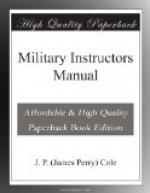1. Look for the water courses,
that is the drainage system. It will
give the general slope of the land.
2. Look for the high points
between the water courses, remembering
that there is always a valley then a hill then a valley
again continued in succession.
3. Finally locate towns, railroads,
main highways and work down to the
minor details.
In measuring a map to get the actual distances on the ground, copy the graphic scale on any piece of paper and apply this directly or if your distances exceed your scale use the edge of a piece of paper and then apply it to the graphical scale on the map.
LESSON 2. (FIELD WORK—FIVE HOURS.)
Problem—Stride Scale Map Making.
Producing a map from the actual ground requires certain instruments. The second lesson takes up the preparation of the stride scale on the alidade and the different kinds of maps, made in military sketching.
The alidade is a triangular ruler with one or more working scales on it beside other measurements. The working scale is, for infantry, the stride or the space of ground covered from left foot to left foot again in walking, reduced to the proper map distance. This varies with individuals of course. Any scale of units, however, can be used as, horse trot, telegraph poles, etc.
The working scale for each man is made by having him step off a measured course, say 440 yards. The ground should not be too even as a general average is needed, moreover the pace must be the natural gait of the individual under ordinary circumstances. Let him count the course three times then average the three results for the final estimate.
Now to convert this into a working scale for the alidade made on a scale of six inches to the mile; take the case of a man who takes 220 strides in 440 yards:
440 yards = 15,840 inches
15,840 / 220 = 72, or his stride in inches
then 880 strides = 1 mile or 6” on the
scale.
It is better to have a scale of 1,000 strides which is easily done by the proportion:
1,000 sts. : 880 sts. : : x :
6
x
= 6.8
now draw a line 6.8 inches long and a diagonal line from it; divide this diagonal line into 10 equal parts for each 100 paces at any convenient scale and draw a line from the end of the tenth part to the end of the 6.8 inches line; draw lines parallel to this line from each of the divisions. The 6.8” line is then divided into 10 equal parts; each of these parts may be divided in the same manner into tenths.
Your scale is ready to be pasted or transferred to the alidade and each 6.8. inches on the map will equal 1,000 of your strides on the ground, or about 1-1/12 miles (2,000 yards).
There are two general classes of sketches:
1. ROAD SKETCH.—A traverse (passing over) made along a definite rout showing all features of military importance for a distance of 200 or 300 yards on each side of the road. A road sketch is always made on a scale of 3 inches to 1 mile.




